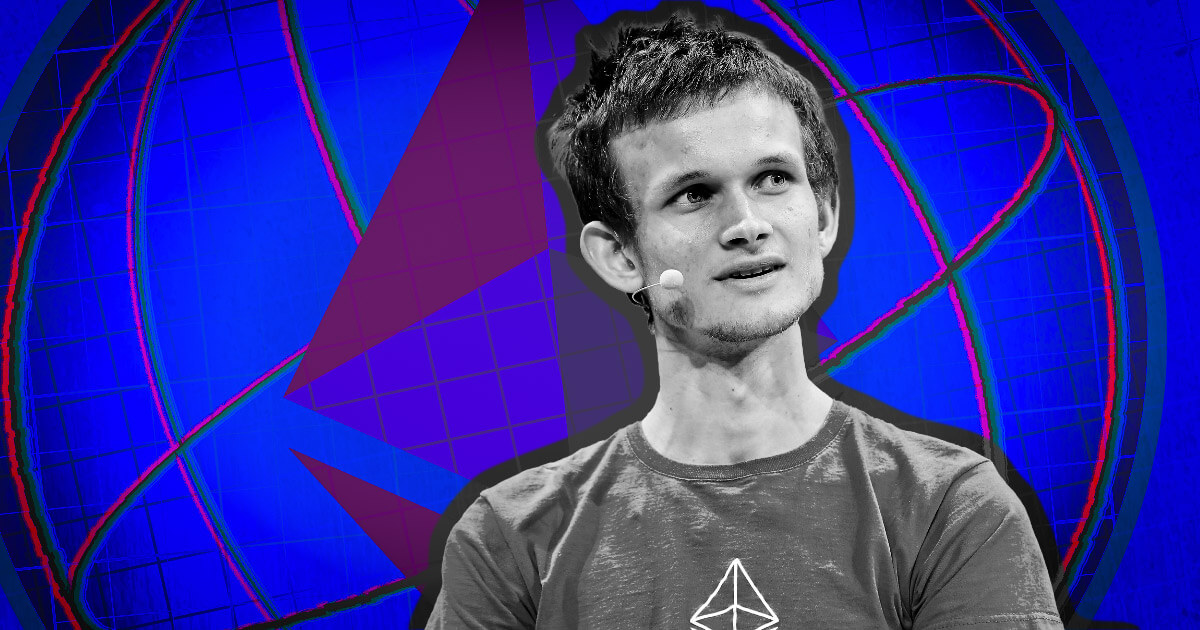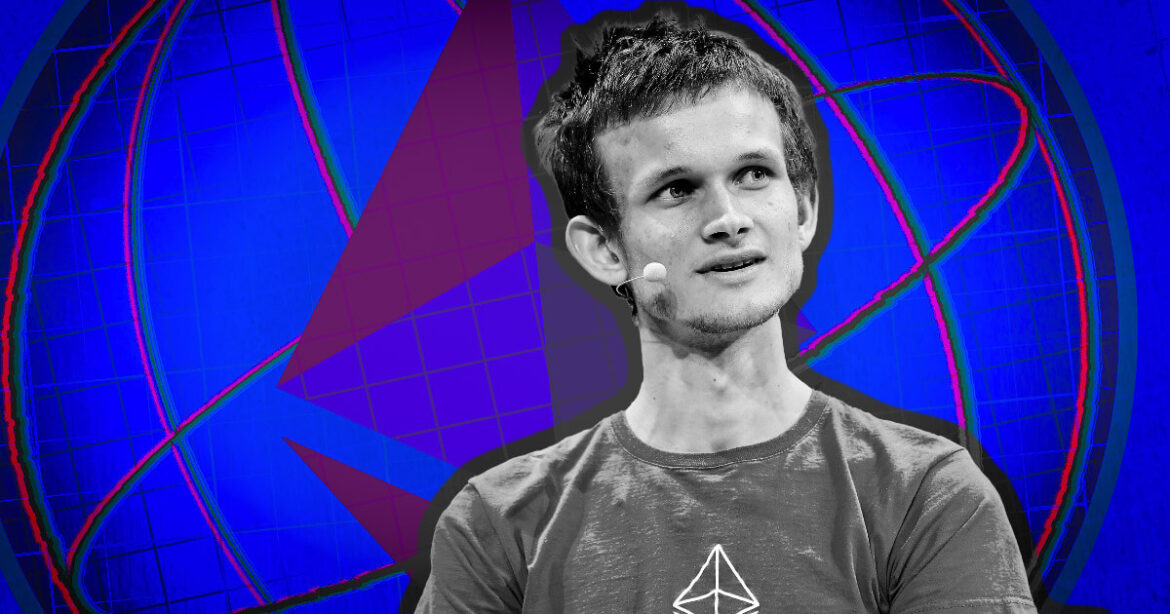 According to blockchain analytics, the Ethereum Name Service (ENS) domain “vitalik.eth” has engaged in a transaction of $100,000 worth of ether, converting it into an equal amount of stablecoins on the Base blockchain. The address, purportedly belonging to Ethereum’s co-founder Vitalik Buterin, currently possesses 955.58 ether, estimated at $3.64 million. ‘Vitalik.eth’ Wallet Makes Strategic $100K […]
According to blockchain analytics, the Ethereum Name Service (ENS) domain “vitalik.eth” has engaged in a transaction of $100,000 worth of ether, converting it into an equal amount of stablecoins on the Base blockchain. The address, purportedly belonging to Ethereum’s co-founder Vitalik Buterin, currently possesses 955.58 ether, estimated at $3.64 million. ‘Vitalik.eth’ Wallet Makes Strategic $100K […]
Source link
Vitalik
ENS token surges 35% to defy market trend after Vitalik calls the platform ‘super important’

Ethereum Name Service’s native token ENS surged over 40% on Jan. 3 after Ethereum co-founder Vitalik Buterin spoke positively about the platform and said it was “super important” for the ETH ecosystem.
As of press time, ENS was trading at approximately $13.94, up 40.38% over the last 24 hours. The token has a market cap of around $423.20 million.
The token’s trading volume over the same period stood at roughly $364.28 million, indicating a high level of market activity.
Addresses linked to Ethereum names collectively control around $277 million in various cryptocurrencies, including ether, wrapped ether, USDC, and Uniswap tokens. The large sum is indicative of substantial financial activity within the ENS ecosystem.
ENS integration
Buterin’s endorsement of ENS, describing it as “super important,” has played a pivotal role in the upward trend.
He believes that Layer-2 blockchains must integrate ENS domains to enhance the user experience in decentralized finance (DeFi) as they need a trustless, Merkle-proof-based CCIP resolver. Such integration would allow ENS subdomains to be registerable, updatable, and readable directly on Layer-2 platforms.
Buterin also recently proposed a new tax on ENS domain names, aiming to ensure broader brand adoption and decentralized ownership of ENS addresses. The proposed tax involves a 3% annual fee based on the highest bid for a domain name.
This fee model is intended to discourage the hoarding of domain names for profit and encourage their use by entities who will actively use them, thus promoting wider adoption and potentially benefiting ENS token holders as the funds from these fees would support the DAO (Decentralized Autonomous Organization) associated with ENS.
Demand-based recurring pricing
Buterin also previously suggested alternatives to Harberger taxing ENS domains in 2022.
Instead of Harberger’s model, where asset owners set their asset’s value and pay a percentage of it in yearly taxes, Buterin proposed a demand-based recurring pricing model.
This model would see annual domain fees rise in proportion to a domain’s valuation, which in turn would increase based on open bids made by other users. The goal of this approach is to create a fairer and more dynamic pricing mechanism that reflects the actual demand and value of ENS domain names.

Ethereum has released its roadmap for 2024, focusing on scalability, security, and sustainability improvements.
Ethereum co-founder Vitalik Buterin announced the plan on social media on Dec. 31, outlining several key initiatives for the platform’s development.
Enhancements in scalability
In 2022, Ethereum underwent a significant change known as ‘The Merge,’ transitioning from a proof-of-work (PoW) to a proof-of-stake (PoS) consensus mechanism. The transition is expected to reduce the platform’s energy consumption and lay the groundwork for future enhancements.
‘The Surge,’ a crucial component of Ethereum’s roadmap, aims to increase network scalability through data sharding. By dividing the blockchain into smaller parts, Ethereum intends to boost its transaction processing capabilities and reduce costs, addressing one of the most pressing issues faced by blockchain technologies today.
This development is expected to bring Ethereum closer to achieving its goal of processing over 100,000 transactions per second, as noted by Buterin in recent statements.
Network streamlining and future research
‘The Scourge’ and ‘The Verge’ focus on enhancing network security and user experience, respectively.
The Scourge is designed to tackle potential security vulnerabilities and improve the robustness of the network, including the challenges posed by Miner Extractable Value (MEV) and liquidity pooling.
On the other hand, The Verge aims to streamline user experiences and provide improved tools for developers, making Ethereum more accessible and efficient.
The roadmap also includes ‘The Purge’ and ‘The Splurge.’
The Purge involves removing outdated code to improve network efficiency and security.
Meanwhile, The Splurge represents an investment in Ethereum’s future, exploring emerging technologies like zero-knowledge proofs and rollups and fostering innovation within the Ethereum ecosystem.
Foundational principles
Buterin has emphasized the need for Ethereum to reconnect with its original cypherpunk vision, which prioritizes decentralized applications, privacy protection, and peer-to-peer communication.
This includes integrating rollups and zero-knowledge proofs to enable more private and censorship-resistant applications on the Ethereum network.
Ethereum’s 2024 roadmap reflects a comprehensive strategy to address current challenges and capitalize on emerging opportunities in the blockchain space. With a focus on scalability, security, sustainability, and staying true to its foundational principles, Ethereum is poised to strengthen its position as a leader in the digital currency ecosystem.
Vitalik Buterin-linked biotech charity Kanro transfers $15M to fund grant

Disclaimer: This article has been updated to reflect clarification from the Ethereum Foundation that Buterin was a signer on a separate multisig wallet transfer and did not directly send funds to Gemini.
The Ethereum Foundation has shed light on a recent $15 million USD Coin (USDC) transaction involving Ethereum co-founder Vitalik Buterin which garnered the attention of several blockchain tracking platforms.
On Oct. 17, posts from blockchain analytics firm PeckShield and Lookonchain on X both claimed that Buterin’s wallet, known as “vitalik.eth” transferred $14.93 million to the Gemini crypto exchange on Oct. 16.
However, an Ethereum Foundation spokesperson told Cointelegraph that the transfer was nothing more than Buterin’s Ethereum Name Service (ENS) signing off on a transfer from a charity multisig wallet to fund a grant, adding that the funds never actually left Buterin’s wallet.
#PeckShieldAlert #vitalik.eth haas transferred ~15M $USDC (Multisig Contract 0xf207…D5a3) to #Gemini pic.twitter.com/6FZGKLKg9Z
— PeckShieldAlert (@PeckShieldAlert) October 17, 2023
Kanro is a biotech charity funded by Buterin that aims to address COVID-19 and other pandemic-related issues.
This will be done under my entity Kanro with its multisighttps://t.co/qloGu4a4vK
where @CryptoRelief_ and I are going to disburse the funds to.
— vitalik.eth (@VitalikButerin) June 8, 2023
Related: Ethereum losing streak vs. Bitcoin hits 15 months — Can ETH price reverse course?
Buterin’s various crypto transfers have been in the limelight over the last several months, while transfers from Buterin’s wallets totaled more than $3.9 million in September.
On Sept. 24, Buterin transferred 400 ETH — worth $600,000 at the time — to Coinbase. Cointelegraph also reported a 600 ETH ($1 million) transaction from the vitalik.eth address on Aug. 21, which was also identified by on-chain monitoring platforms.
Collect this article as an NFT to preserve this moment in history and show your support for independent journalism in the crypto space.
Magazine: Are DAOs overhyped and unworkable? Lessons from the front lines
Update (8:45 am Oct. 17): This article has been corrected to reflect details provided by an Ethereum Foundation spokesperson.
Vitalik Buterin Discusses Certain Changes to Ethereum Staking, What’s Coming Next?
Ethereum co-founder Vitalik Buterin also raised concern regarding the concentration of Ethereum’s liquid staking providers.
In his recent blog post, Ethereum co-founder Vitalik Buterin shared his opinion on adding some protocols to the Ethereum blockchain code. He also touched upon the most important part which is the concentration of liquid staking service providers.
Vitalik Buterin discussed several Ethereum protocols, including the account abstraction protocol ERC-4337, ZK-EVMs, private mempools, code precompiles, and liquid staking. He expressed stronger support for “enshrining” some of these protocols, such as ERC-4337, in Ethereum’s code, while he had reservations about others like private mempools. However, he acknowledged that each protocol presents a complex tradeoff that will continue to evolve over time.
Buterin also raised concerns about the concentration of Ethereum’s liquid staking providers. Notably, Lido currently controls over 32% of staked ether, albeit across different validators. Buterin highlighted that both Lido and Rocket Pool, two major providers, carry different risks and have some safety measures in place, though these might not be sufficient.
Rather than relying solely on “moralistic pressure” to promote a more diverse set of staking providers, Buterin contemplated potential protocol changes aimed at further decentralizing liquid staking. These changes could involve adjusting RocketPool’s approach or granting additional governance powers to a randomly selected committee of small stakers.
ETH Price Gains Before Ethereum Futures Launch
In the last 24 hours, the Ethereum (ETH) price has gained more than 3.5% shooting all the way to the $1,750 level. The price move comes ahead of the launch of Ethereum futures ETFs and $1,750 serves as a key resistance level for Ethereum.
Ethereum faces major resistance at $1,800, and a successful breakthrough could pave the way for further gains toward $1,850 and $1,920, potentially even reaching $2,000. On the downside, if Ethereum fails to surpass the $1,750 resistance, it may initiate a corrective move.
Initial support lies around the $1,710 level, with a more critical support at $1,680. Additionally, the 76.4% Fibonacci retracement level from the recent rally, positioned near $1,685, offers support. A breach below $1,685 might test the $1,650 support, potentially triggering a bearish trend towards the $1,600 level.
As per the schedule and plans, the Ethereum futures ETF from Bitwise is likely to go live later today, October 2. As of a September 27 note, there are 15 Ether futures ETFs from nine different issuers awaiting approval. These issuers include well-known names like VanEck, ProShares, Grayscale, Volatility Shares, Bitwise, Direxion, and Roundhill.
The analysts assessing the situation have assigned a 90% likelihood of Ether futures ETFs launching in October. Among these offerings, Valkyrie’s Bitcoin futures product, with Bitcoin trading at approximately $28,308, is expected to be the first to include exposure to Ether starting on October 3.
next
Blockchain News, Cryptocurrency News, Ethereum News, News

Bhushan is a FinTech enthusiast and holds a good flair in understanding financial markets. His interest in economics and finance draw his attention towards the new emerging Blockchain Technology and Cryptocurrency markets. He is continuously in a learning process and keeps himself motivated by sharing his acquired knowledge. In free time he reads thriller fictions novels and sometimes explore his culinary skills.
You have successfully joined our subscriber list.
Vitalik Buterin has transferred over 1.8k ETH to exchanges this year, still holds over 250k ETH
What is CryptoSlate Alpha?
A web3 membership designed to empower you with cutting-edge insights and knowledge. Learn more ›
Connected to Alpha
Welcome! 👋 You are connected to CryptoSlate Alpha. To manage your wallet connection, click the button below.
Oops…you must lock a minimum of 20,000 ACS
If you don’t have enough, buy ACS on the following exchanges:
Connect via Access Protocol
Access Protocol is a web3 monetization paywall. When users stake ACS, they can access paywalled content. Learn more ›
Disclaimer: By choosing to lock your ACS tokens with CryptoSlate, you accept and recognize that you will be bound by the terms and conditions of your third-party digital wallet provider, as well as any applicable terms and conditions of the Access Foundation. CryptoSlate shall have no responsibility or liability with regard to the provision, access, use, locking, security, integrity, value, or legal status of your ACS Tokens or your digital wallet, including any losses associated with your ACS tokens. It is solely your responsibility to assume the risks associated with locking your ACS tokens with CryptoSlate. For more information, visit our terms page.
Vitalik Buterin sim-swap hack exposes Twitter Blue account security flaw
What is CryptoSlate Alpha?
A web3 membership designed to empower you with cutting-edge insights and knowledge. Learn more ›
Connected to Alpha
Welcome! 👋 You are connected to CryptoSlate Alpha. To manage your wallet connection, click the button below.
Oops…you must lock a minimum of 20,000 ACS
If you don’t have enough, buy ACS on the following exchanges:
Connect via Access Protocol
Access Protocol is a web3 monetization paywall. When users stake ACS, they can access paywalled content. Learn more ›
Disclaimer: By choosing to lock your ACS tokens with CryptoSlate, you accept and recognize that you will be bound by the terms and conditions of your third-party digital wallet provider, as well as any applicable terms and conditions of the Access Foundation. CryptoSlate shall have no responsibility or liability with regard to the provision, access, use, locking, security, integrity, value, or legal status of your ACS Tokens or your digital wallet, including any losses associated with your ACS tokens. It is solely your responsibility to assume the risks associated with locking your ACS tokens with CryptoSlate. For more information, visit our terms page.
Vitalik Buterin’s X account hacked, over $691K drained from victims’ wallets

Vitalik Buterin, Ethereum’s co-founder, allegedly had his X (formerly Twitter) account compromised. According to prominent blockchain investigator ZachXBT, the incident has led to victims collectively losing over $691,000 after clicking on a malicious link.
In a Sept. 9 post on X, Dmitry Buterin, the father of Vitalik, announced that his son’s account had been compromised:
“Disregard this post, apparently Vitalik has been hacked. He is working on restoring access.”
The post he was referring to has since been deleted. It was published on Buterin’s account, claiming to celebrate the arrival of “Proto-Danksharding coming to Ethereum.“
The hacker shared a malicious link to an alleged free commemorative nonfungible token (NFT) available, enticing victims to connect their wallets before ultimately stealing all their funds.
Consequently, this incident has led Ethereum developer Bok Khoo, better known as Bokky Poobah on X, to claim he has suffered losses in his CryptoPunk NFT collection.
WARNING! I JUST LOST A FEW PUNKS!
DON’T INTERACT! pic.twitter.com/lS4VvlHdVa
— luckytimes.eth beautifuldaytobealive.eth (@BokkyPooBah) September 9, 2023
At the time of publication, the prevailing floor price for a CryptoPunk NFT stands at 46.99 Ether (ETH), which is approximately equivalent to $76,837.
Related: Blockchain Capital’s X account hacked to promote token claim scam
ZachXBT has been actively informing his 438,200 followers about the hacker’s activities. He recently shared that the most valuable NFT pilfered so far is CryptoPunk #3983, worth 153.62 ETH, equivalent to approximately $250,543.
Update: $691k drained (another 33% in drainer fee address) pic.twitter.com/AVIShqDlMU
— ZachXBT (@zachxbt) September 9, 2023
A user with the alias Satoshi 767 suggested that Buterin might not have implemented sufficient security measures for his X account, noting that SIM-swap attacks are a “common mistake” for many crypto project founders.
However, ZachXBT challenged these allegations, asserting that Buterin’s high profile makes him susceptible to various forms of hacking attempts:
“You do not know yet whether it was a SIM swap. Vitalik is a big enough target to where an insider could have been paid off or panel was used,” ZachXBT stated.
Magazine: How to protect your crypto in a volatile market: Bitcoin OGs and experts weigh in
Vitalik Buterin wants Bitcoin to experiment with layer-2 solutions, just like Ethereum

Ethereum co-founder Vitalik Buterin believes the Bitcoin network needs scalable solutions like zero-knowledge rollups (ZK-rollups) to become more than another payment network. Buterin’s comments came during a Twitter Space hosted by Bitcoin developer Udi Wertheimer, with discussions revolving around Ethereum’s scaling experiments.
A ZK-rollup is an off-chain protocol that operates on top of the Ethereum blockchain and is managed by on-chain Ethereum smart contracts. It offers a more scalable and faster way to verify transactions without sharing critical user information.
The Ethereum co-founder shed light on how Ethereum has incorporated various scaling solutions over the years to increase throughput. Buterin cited Optimism and Arbitrum as two successful examples of rollups that could be considered case studies for Bitcoin, adding:
“I think if we want Bitcoin to be more than payments, it needs more scaling solutions”
Scalability has been a long-drawn point of discussion for Bitcoin and Ethereum over the years. While the Ethereum network has shifted from a proof-of-work to a proof-of-stake network, it is also experimenting with various layer-2 solutions like ZK-rollups and Plasma.
Related: Zero-knowledge proofs coming to Bitcoin, overhauling network state validation
On the other hand, Bitcoin’s layer-2 solution, the Lightning Network, has been crucial to its scalability, and lately, Bitcoin Ordinals have helped the Bitcoin network become more than just another payment layer. Buterin lauded the rise of Ordinals and said he thinks they have brought back the builder culture into the Bitcoin ecosystem.
Bitcoin Ordinals are the latest layer-2 solution enabling decentralized storage of digital art on the Bitcoin blockchain. Its popularity soared fast, and by the end of June, Bitcoin Ordinals inscriptions hit over $210 million in trading volume.
Collect this article as an NFT to preserve this moment in history and show your support for independent journalism in the crypto space.
Magazine: ‘Moral responsibility’ — Can blockchain really improve trust in AI?









